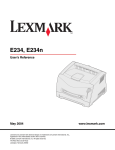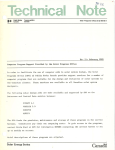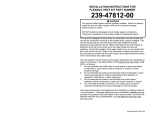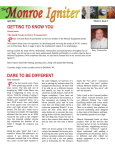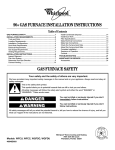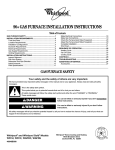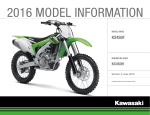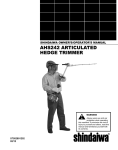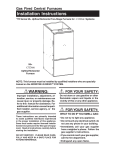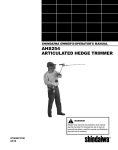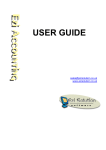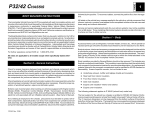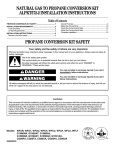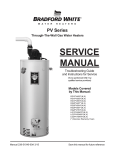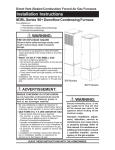Download 506185-01 CG90s CB TB UB Issue 0938.pmd - Aire-Flo
Transcript
INSTALLATION INSTRUCTIONS CG90CB, CG90UB, CG90TB, CG92TB & CG95TB High Efficiency 90+ Condensing Gas Furnace Save these instructions for future reference WARNING Improper installation, adjustment, alteration, service, or maintenance can cause injury or property damage. Refer to this manual. For assistance or additional information, consult a qualified installer, service agency, or the gas supplier. WARNING TABLE OF CONTENTS Do not store combustible materials, including gasoline and other flammable vapors and liquids, near the furnace, vent pipe, or warm air ducts. The homeowner should be cautioned that the furnace area must not be used as a broom closet or for any other storage purposes. Such uses may result in actions that could cause property damage, personal injury, or death. SAFETY ................................................. 2 INSTALLATION ...................................... 3 START-UP ............................................ 26 OPERATION ........................................ 27 MAINTENANCE ................................... 30 WARNING REPAIR PARTS ................................... 31 This furnace is not approved for installation in a mobile home. Do not install this furnace in a mobile home. Installation in a mobile home could result in actions that could cause property damage, personal injury, or death. CONTROL SYSTEM DIAGNOSTICS .. 32 WIRING DIAGRAMS............................ 33 Manufactured By Allied Air Enterprises Inc. A Lennox International Inc. Company 215 Metropolitan Drive West Columbia, SC 29170 *506185-01* WARNING The installation of the furnace, wiring, warm air ducts, venting, etc. must conform to the requirements of the National Fire Protection Association; the National Fuel Gas Code, ANSI Z223.1/NFPA No. 54 (latest edition) and the National Electrical Code, ANSI/NFPA No. 70 (latest edition) in the United States; CSA B149.1 (latest edition) Natural Gas and Propane Installation Codes and the Canadian Electrical Code Part 1, CSA 22.1 (latest edition) in Canada; and any state or provincial laws, local ordinances (including plumbing or wastewater codes), or local gas utility requirements. Local authorities having jurisdiction should be consulted before installation is made. Such applicable regulations or requirements take precedence over the general instructions in this manual. 506185-01 Issue 0938 Page 1 of 36 IMPORTANT SAFETY INFORMATION The following is a list of safety rules and precautions that must be followed when installing this furnace. 1. Use only with the type of gas approved for this furnace. Refer to the furnace rating plate. 2. Install this furnace only in a location and position as specified in the Location section on page 3 of these instructions. 3. Provide adequate combustion and ventilation air to the furnace space as specified in the Combustion and Ventilation Air section on page 4 of these instructions. 4. Adequate clearance must be provided around the ventair intake terminals as specified in the Venting section beginning on page 5 of these instructions. 5. Combustion products must be discharged outdoors. Connect this furnace to an approved vent system only, as specified in the Venting section beginning on page 5 of these instructions. 6. Never test for gas leaks with an open flame. Use a commercially available soap solution made specifically for the detection of leaks to check all connections, as specified in Gas Supply and Piping beginning on page 22 of these instructions. Page 2 of 36 7. Always install furnace to operate within the furnace’s intended temperature-rise range with a duct system which has an external static pressure within the allowable range, as specified in Temperature Rise on page 28 of these instructions. See furnace rating plate. 8. When a furnace is installed so that the supply ducts carry air circulated by the furnace to areas outside the space containing the furnace, the return air shall also be handled by duct(s) sealed to the furnace casing and terminating outside the space containing the furnace. See Circulating Air Supply on page 22 of these instructions. 9. A gas-fired furnace for installation in a residential garage must be installed as specified in the Location section on page 3 of these instructions. 10. The furnace is permitted to be used for temporary heating of buildings or structures under construction as specified in the Location section beginning on page 3 of these instructions. In the State of Massachusetts: This product must be installed by a licensed Plumber or Gas Fitter. When flexible connectors are used, the maximum length shall not exceed 36". When levertype gas shutoffs are used, they shall be T-handle type. Issue 0938 506185-01 INSTALLATION These instructions must be placed on or near the furnace in a conspicuous place. The furnace design is certified by CSA International as a Category IV furnace in compliance with the latest edition of American National Standard Z21.47/CSA Standard 2.3 for Gas-Fired Central Furnaces, for operation with natural gas or propane. Consult the rating plate on the furnace for gas type before installing. Location To provide proper operation and satisfactory performance, care must be taken in choosing the location for this furnace. The atmosphere in which the furnace operates must be free of contaminants such as chlorides and sulfates. The furnace must be installed so that electrical components are protected from water. Unit must be level for proper condensate drainage. WARNING The maximum hourly heat loss of space shall be calculated in accordance with the procedure described in the current manuals of Air Conditioning Contractors of America, or by any other recognized method which is suitable for local conditions, provided the results obtained are in substantial agreement with, and not less than, those obtained using the procedure described in the manuals. CG90UB models shall be installed only as upflow furnaces. CG90CB models shall be installed only as counterflow (downflow) furnaces. CG90TB and CG92TB & CG95TB models may be installed as upflow or horizontal right to left or left to right airflow furnaces. When installed horizontally, the installer must install a sheet metal screw to retain the upper door as shown in Figure 1. Horizontal Installations The condensate drain on this furnace is incorporated within the furnace and must be primed before start-up. The condensate system must not be exposed to temperatures under 32°F. Use of heat tape is permissible provided the rate temperature of the tape does not exceed 155°F. Never install any furnace on its back. To avoid property damage caused by condensate drain blockage, install a field-fabricated auxiliary drain pan with a separate drain line to the outside under the entire furnace and drain system. Install according to local codes. All models are suitable for closet or utility room installation. The furnace is suitable for installation in buildings constructed on-site. The furnace should be centralized in respect to the heat distribution system as much as practicable. When installed in a utility room, the door should be wide enough to allow the largest part of the furnace to enter, or permit the replacement of another appliance, such as a water heater. A gas-fired furnace for installation in a residential garage must be installed so the burner(s) and the ignition source are located not less than 18" above the floor. The furnace is to be located or protected to avoid physical damage by vehicles. This furnace is not recommended to be used as a construction heater during any phase of construction. Very low return air temperatures, harmful vapors, and operation of the unit with clogged or misplaced filters will damage the unit. HORIZONTAL RIGHT TO LEFT AIRFLOW SHOWN The furnace may be used for heating of buildings or structures under construction, if the following conditions are met: Figure 1 Inspection of Shipment This furnace is shipped in one package, completely assembled and wired. The thermostat is shipped in a separate carton when ordered. Upon receipt of equipment, carefully inspect it for possible shipping damage. If damage is found, it should be noted on the carrier’s freight bill. Damage claims should be filed with the carrier immediately. Claims of shortages should be filed with the seller within 5 days. 506185-01 • The vent system must be permanently installed per these installation instructions. • A room thermostat must control the furnace. The use of fixed jumpers that will provide continuous heating is not allowed. • The return air duct must be provided and sealed to the furnace. Issue 0938 Page 3 of 36 • Return air temperature range between 60°F and 80°F must be maintained. • Air filters must be installed in the system and must be maintained during construction. • Air filters must be replaced upon construction completion. • The input rate and temperature rise must be set per the furnace rating plate. • One hundred percent (100%) outdoor air must be provided for combustion air requirements during construction. Temporary ducting may supply outdoor air to the furnace. Do not connect duct directly to the furnace. Size the temporary duct following the instructions provided on this page in the Combustion and Ventilation Air section regarding confined space with air from outside. • The furnace heat exchanger, components, duct system, air filters, and evaporator coils must be thoroughly cleaned following final construction cleanup. • All furnace operating conditions (including ignition, input rate, temperature rise, and venting) must be verified according to these installation instructions. CG90UB, CG90TB, CG92TB and CG95TB models may be installed on wood flooring but shall not be installed directly on carpeting, tile, or any other combustible material. CG90CB counterflow models are certified for installation on combustible flooring provided a special base assembly is used. (Refer to the Duct Connection – Counterflow Models section on page 22 for more information on using the special base assembly.) When a counterflow unit is installed on a combustible floor, 1" clearance must be provided between the supply duct and the floor. Combustion and Ventilation Air Adequate provisions for combustion air and ventilation of furnace must be made. Refer to Section 5.3, “Air for Combustion and Ventilation,” of the National Fuel Gas Code, ANSI Z223.1/NFPA54 (latest edition), Sections 7.2, 7.3, or 7.4 of CSA B149.1 Natural Gas and Propane Installation Codes (latest editions), or applicable provisions of the local building codes. WARNING Insufficient combustion air can cause headaches, nausea, dizziness, or asphyxiation. When considering combustion air requirements, enough air must also be provided to meet the needs of all fuel-burning appliances and exhaust fans. If the furnace is to be installed in an attic or other insulated space, it must be kept free and clear of insulating materials. Clearances All servicing and cleaning of the furnace can be performed from the front. If installed in a closet or utility room, provide 18" clearance in front for service if the door to the room is not in line with the front of the furnace. WARNING Air openings in the front of the furnace must be kept free of obstructions. Any obstruction may cause improper operation that can result in a fire hazard or carbon monoxide injury. Refer to Table 1 for the minimum clearances to combustibles required for construction and proper unit operation. Accessibility clearances must take precedence over fire protection clearances. Minimum Clearances to Combustibles Unconfined Space An unconfined space is defined as “a space whose volume is more than 50 cubic feet per 1000 BTU per hour of the combined input rating of all appliances installed in that space.” When a furnace is installed in an unconfined space in a building, it can be assumed that the infiltration will be sufficient to supply the required air. If the furnace is installed in a ventilated attic or crawl space, it is assumed that the infiltration is sufficient to supply the required air. However, in a building of unusually tight construction, additional outdoor air should be provided. Table 1 Page 4 of 36 Issue 0938 506185-01 Confined Space A confined space is defined as “a space whose volume is less than 50 cubic feet per 1000 BTU per hour of the combined input rating of all appliances installed in that space.” 5. Exposure to the following substances in the combustion air supply may also require outdoor air for combustion: • • • • • • • • • • • • • • If the furnace is installed in a confined space within the building and combustion air is taken from a heated space, the combustion air and ventilating air must enter and leave the space through two permanent openings of equal area. One opening shall be located within 12" of the ceiling and the other within 12" of the floor, each having a free area of 1 square inch per 1000 BTU/HR of total input rating of all appliances within the space and not less than 100 square inches each. If the furnace is installed in a space within a building of tight construction, makeup air must be supplied from outdoors. In this case, one opening shall be within 12" of the ceiling and one opening within 12" of the floor. If combustion ducts are vertical, each opening shall have a free area of 1 square inch per 4000 BTU/HR of the total input rating of all appliances within the enclosure. If horizontal combustion ducts are run, 1 square inch per 2000 BTU/HR is required. Contaminated Combustion Air Excessive exposure to contaminated combustion air will result in safety and performance related problems. The recommended source of combustion air is outdoor air. However, the use of indoor air in most applications is acceptable if the following guidelines are followed: 1. If the furnace is installed in a confined space, it is recommended that the necessary combustion air come from the outdoors by way of an attic, crawl space, air duct, or direct opening. 2. If indoor combustion air is used, there must be no exposure to the substances listed in item 5. 3. All provisions for indoor combustion air must meet the requirements for combustion air indicated in the National Fuel Gas Code, ANSI Z223.1/NFPA 54 (latest edition), and/or any applicable local codes. In Canada, see CSA B149.1, Natural Gas and Propane Installation Codes (latest edition). Venting The high efficiency of this furnace is accomplished by the removal of both sensible and latent heat from the flue gases. The removal of latent heat results in the condensation of moisture in the flue gases. This condensation occurs in the secondary heat exchanger and in the vent system. Therefore, this furnace requires special venting considerations and the instructions must be followed to insure proper operation. All venting must be in accordance with the codes having jurisdiction in the area and these instructions. CG90UB, CG90TB, CG92TB, CG95TB and CG90CB models can be installed as either direct vent or non-direct vent units. A direct vent (two pipe) installation requires that all the air necessary for combustion be supplied from outside the dwelling through an air intake pipe. A non-direct vent (one pipe) installation uses air from inside the dwelling for combustion. The furnace is shipped with the air inlet pipe terminated to the top panel for either inside or outside combustion air. An inlet air restrictor plate (see Figure 2) is supplied with this furnace and can be found in the plastic bag containing these Installation Instructions and the User’s Information Manual. The inlet restrictor plate must be used in all installations using inside air for combustion (non-direct vent). 4. The following types of installation may require outdoor air for combustion, due to chemical exposures: • • • • • Commercial buildings Buildings with indoor pools Furnaces installed in laundry rooms Furnaces installed in hobby or craft rooms Furnaces installed near chemical storage areas 506185-01 Permanent wave solutions Chlorinated waxes and cleaners Chlorine-based swimming pool chemicals Water softening chemicals Deicing salts or chemicals Carbon tetrachloride Halogen-type refrigerants Cleaning solvents (such as perchloroethylene) Printing inks, paint removers, varnishes, etc. Cements and glues Antistatic fabric softeners for clothes dryers Masonry acid washing materials Chlorinated laundry products Hydrochloric acid Inlet Air Restrictor Plate The inlet air restrictor plate must be installed in all installations using inside air for combustion (non-direct vent). Figure 2 Issue 0938 Page 5 of 36 The inlet restrictor plate must be installed in the air inlet in one of three ways: • • • Restrictor plate in inlet collar: Install the restrictor plate in the inlet pipe collar in the top panel of the furnace. Insert a 3" to 36" section of PVC pipe (field supplied) into the collar. Use high temperature RTV sealant to attach PVC pipe to collar. A 90° elbow (field supplied) may be attached to the PVC pipe, but the elbow is not required. Use high temperature RTV sealant to attach elbow to PVC pipe (if applicable). Restrictor plate in inlet pipe: Insert a 3" to 36" section of PVC pipe (field supplied) into the collar. Use high temperature RTV sealant to attach PVC pipe to collar. Install the restrictor plate in the end of the inlet pipe just installed. Attach either a field-supplied coupler or 90° elbow to the end of the PVC pipe to keep the restrictor plate in place. Use high temperature RTV sealant to attach the coupler or elbow to PVC pipe. Restrictor plate in elbow: Insert a 3" to 36" section of PVC pipe (field supplied) into the collar. Use high temperature RTV sealant to attach PVC pipe to collar. Attach a 90° elbow (field supplied) to the PVC pipe. Use high temperature RTV sealant to attach elbow to PVC pipe. Install the restrictor plate into the elbow. When a furnace is installed as direct vent, provisions for ventilation air should follow the same requirements as if installed as non-direct vent. Proper ventilation air is necessary to maintain furnace component temperatures within acceptable limits. All vents passing through floors, ceilings, and walls must be installed in accordance with National Fuel Gas Code, ANSI Z223.1/NFPA 54 (latest edition). The length of flue pipe exposed to outdoor conditions should be kept to a minimum. When the installation requires more than 3 feet of flue pipe be exposed to outdoor conditions, insulating the exposed flue pipe with 1/2” Armaflex or equivalent is recommended. In climates with design temperatures below zero degrees (F), 3/4” Armaflex or equivalent is recommended. Materials All pipe, fittings, primer, and solvent cement must conform with American National Standard Institute and the American Society for Testing and Materials (ANSI/ASTM) standards. Piping and Fitting Specifications Two different sized inlet restrictor plates are supplied with the furnace (2" and 3"). Use the proper restrictor plate for the furnace model. WARNING If at any time in the future the installation of this furnace is changed to require outside fresh air for combustion, the inlet air restrictor plate must be removed. Failure to remove the inlet air restrictor could cause improper operation that can result in a fire hazard or carbon monoxide injury. For either type of installation (direct or non-direct vent), special venting considerations must be followed. Refer to the proper section in pages 10 – 17 for the type of furnace and venting being installed. The venting system must be supported with mounting straps to prevent any weight load from being applied to the vent blower. Horizontal vent pipe must be supported every 5' and vertical pipe should be supported every 10' to prevent sagging and provide rigid support. Page 6 of 36 Issue 0938 Table 2 506185-01 The solvent shall be free flowing and contain no lumps, undissolved particles, or any foreign matter that adversely affects the joint strength or chemical resistance of the cement. The cement shall show no gelation, stratification, or separation that cannot be removed by stirring. Refer to Table 2 for approved piping and fitting materials. Canadian Applications Only: PVC pipe, fittings, primer and solvent cement used to vent this applicance must be certified to ULC S636 and supplied by a single manufacturer as part of an approved venting system. In addition, the first three feet of vent pipe from the furnace flue collar must be accessible for inspection. Models that may be installed as a horizontal furnace include a horizontal drain kit. In Canada this drain kit must be replaced by a locally available IPEX Drain Kit # 196014. For Local IPEX Canadian Customer Service Center and Kit abailability call IPEX at 1-866-4739462. The primers and solvents used must also meet ASTM specifications. PVC primer is specified in ASTM F656. Use PVC solvent as specified in ASTM D2564 and ABS solvent cement as specified ASTM D2235. Low temperature solvent cement is recommended. Metal or plastic strapping may be used for vent pipe hangers. When making ABS joints, pieces can be prepared with a clean dry cloth to clean inside socket surface of fitting and male end of pipe to depth of socket. Refer to procedure specified in ASTM D3138. When joining ABS to PVC materials, use transition solvent. Preferred fittings are DWV style or long sweep. Seal all joints gas tight with appropriate cement. In areas where vent and air intake pipes are exposed to abnormal stress or are subject to damage, schedule 80 pipe should be used. Category IV Furnace Limitations This furnace shall not be connected to any Type B, BW, or L vent or vent connector and shall not be connected to any portion of a factory-built or masonry chimney. This furnace is not to be common vented with any other appliance. The vent pipe must not be connected to a chimney flue serving a separate appliance designed to burn solid fuel. Concentric Vent Kit Dimensions Concentric Vent Kit A concentric vent kit (see Accessories section on page 31 for correct kit) is available for use when installing this furnace as a direct vent furnace and the air intake and vent pipe are to be run through the same hole, whether horizontally through the wall or vertically through the roof (see Figure 3). Refer to the instructions included with the concentric vent kit for installation specifics. Vent Pipe Size and Length The vent pipe and air intake pipe (in direct vent installations) should be sized in accordance with the information found in the appropriate table in Figure 4. One 90° elbow is equivalent to 5' of pipe. Two 45° elbows are equivalent to one 90° elbow. The minimum length certified for use with this furnace is 5' and one elbow, not including the vent and air intake terminals. In the event that the pipe length is in between the lengths listed in the table, use the next larger length listed. For example, if a length of pipe needed to install the furnace is 27', use the diameter values for the 30' row in the tables. For direct vent installations, if the vent and air intake pipe are not equal in length and number of elbows, then determine the minimum pipe diameter for both the vent and air intake. If the results indicate different diameters, use the larger of the two for both the vent and air intake. Under no circumstances should the vent and air intake pipe size be different in diameter. For installation details, refer to the appropriate section in pages 10 – 17 for the unit model and type of installation. High Altitude Installation: 2” pipe not recommended at altitude above 4,000 feet. 3” pipe required for altitude above 5,000 feet. Horizontal Venting The vent for this appliance shall not terminate over public walkways; or near soffit vents or crawl space vents or other areas where condensate or vapor could create a nuisance or hazard or cause property damage; or where condensate vapor could cause damage or could be detrimental to the operation of regulators, relief valves, or other equipment. See Figures 5 and 6 on pages 9 and 10 for additional information on where the horizontal vent terminal can and cannot terminate. For Massachusetts Installations: The installation must comply with Massachusetts 248 CMR 5.08 Modifications to sections of NFPA-54, Chapter10. (See pages 35 and 36 ) Figure 3 506185-01 Issue 0938 Page 7 of 36 Vent Tables * (numbers in inches unless specified otherwise) Minimum Pipe Diameter 40,000 – 75,000 BTU/HR Models Minimum Pipe Diameter 80,000 – 100,000 BTU/HR Models Minimum Pipe Diameter 112,000 – 125,000 BTU/HR Models NR = Not Recommended * 2” not recommended at altitude above 4,000 feet 3” required for altitude above 5,000 feet Figure 4 Page 8 of 36 Issue 0938 506185-01 Sidewall Vent Terminal Clearances (Direct Vented Furnaces) A ** Minimum 12” (30 cm) above grade or 12” (30 cm) above average snow accumulation. V Vent Terminal X Air Supply Inlet Area Where Terminal Is Not Permitted 1 2 † In accordance with the current CSA B149.1, Natural Gas and Propane Installation Code In accordance with the current ANSI Z223.1/NFPA 54, National Fuel Gas Code A vent shall not terminate directly above a sidewalk or paved driveway that is located between two single family dwellings and serves both dwellings. ‡ Permitted only if veranda, porch, deck, or balcony is fully open on a minimum of two sides beneath the floor. * For clearances not specified in ANSI Z223.1/NFPA 54 or CSA B149.1, the following statement shall be included: “Clearance in accordance with local installation codes and the requirements of the gas supplier and the manufacturer’s installation instructions.” Figure 5 506185-01 Issue 0938 Page 9 of 36 Sidewall Vent Terminal Clearances (Non-Direct Vented Furnaces) A ** Minimum 12” (30 cm) above grade or 12” (30 cm) above average snow accumulation. V Vent Terminal X Air Supply Inlet Area Where Terminal Is Not Permitted 1 2 † In accordance with the current CSA B149.1, Natural Gas and Propane Installation Code In accordance with the current ANSI Z223.1/NFPA 54, National Fuel Gas Code A vent shall not terminate directly above a sidewalk or paved driveway that is located between two single family dwellings and serves both dwellings. ‡ Permitted only if veranda, porch, deck, or balcony is fully open on a minimum of two sides beneath the floor. * For clearances not specified in ANSI Z223.1/NFPA 54 or CSA B149.1, the following statement shall be included: “Clearance in accordance with local installation codes and the requirements of the gas supplier and the manufacturer’s installation instructions.” Figure 6 Page 10 of 36 Issue 0938 506185-01 CG90UB, CG90TB, CG92TB and CG95TB Upflow Models – Direct Vent Installation An inlet air restrictor plate (see Figure 2 on page 5) is supplied with this furnace and can be found in the plastic bag containing these Installation Instructions and the User’s Information Manual. This restrictor plate is to be used only in non-direct vent applications. See pages 5 and 6 for more information on installing the restrictor plate in non-direct vent applications. For horizontal venting, refer to Figure 7. For vertical venting, refer to Figure 8. It is permissible to run the vent vertically through the roof and terminate it as shown in Figure 8, and to run the combustion air intake pipe horizontally through a side wall and terminate as shown in Figure 7. The vent pipe on horizontal runs must slope upward, away from the furnace, at a minimum pitch of 1/4" per foot of run, to prevent accumulation of condensate. Do not cement air intake into the connector on burner box. Use high temperature RTV silicone sealant so intake pipe can be removed if service is required. In horizontal venting applications, the vent and air intake pipe must be installed on the same side of the house within the parameters shown in Figure 7. Prime the trap system by slowly pouring 1 cup of water down the vent pipe. On initial start-up of the unit, some of the water used to prime the trap system may run down into the combustion blower and cause noise. Upflow Direct Vent – Vertical Venting (CG90UB, CG90TB, CG92TB & CG95TB Only) Upflow Direct Vent – Horizontal Venting (CG90UB, CG90TB, CG92TB & CG95TB Only) * Maintaining a vertical separation between the flue outlet and the air intake of at least 18” is highly recommended to minimize the chance of flue gases recirculating and freezing in the air intake pipe. This distance may be reduced in milder climates or where wind is unlikely to blow flue products to the intake pipe, but should not be less than 6”. Overhead View FLUE PIPE THIS PIECE IS OPTIONAL. INTAKE PIPE 3” MIN. - 48” MAX. Figure 8 Figure 7 506185-01 Issue 0938 Page 11 of 36 CG90UB, CG90TB, CG92TB & CG95TB Upflow Models – Non-Direct Vent Installation An inlet air restrictor plate (see Figure 2 on page 5) is supplied with this furnace and can be found in the plastic bag containing these Installation Instructions and the User’s Information Manual. This restrictor plate is to be used only in non-direct vent applications. See pages 5 and 6 for more information on installing the restrictor plate in non-direct vent applications. Upflow Non-Direct Vent Vertical Venting (CG90UB, CG90TB, CG92TB & CG95TB Only) Two inlet air restrictor plates are supplied with each furnace – a 2" plate and a 3" plate. Use the proper restrictor plate for the furnace model. For horizontal venting, refer to Figure 9. For vertical venting, refer to Figure 10. The vent pipe on horizontal runs must slope upward, away from the furnace, at a minimum pitch of 1/4" per foot of run, to prevent accumulation of condensate. Prime the trap system by slowly pouring 1 cup of water down the vent pipe. On initial start-up of the unit, some of the water used to prime the trap system may run down into the combustion blower and cause noise. " Upflow Non-Direct Vent Horizontal Venting (CG90UB, CG90TB, CG92TB & CG95TB Only) THRU. " DRAIN HOLE (CLOSED) 59.69/56.64 THE VENT SYSTEM OF THE FURNACE MUST BE SELF-SUPPORTING AND MUST NOT APPLY ANY WEIGHT LOAD TO THE COMBUSTION BLOWER. " DRAIN HOLE (CLOSED) 59.69/56.64 THRU. Figure 10 Figure 9 Page 12 of 36 Issue 0938 506185-01 CG90CB Counterflow Models – Direct Vent Installation An inlet air restrictor plate (see Figure 2 on page 5) is supplied with this furnace and can be found in the plastic bag containing these Installation Instructions and the User’s Information Manual. This restrictor plate is to be used only in non-direct vent applications. See pages 5 and 6 for more information on installing the restrictor plate in non-direct vent applications. Do not cement air inlet pipe. Use high temperature RTV silicone sealant so inlet pipe can be removed if service is required. For horizontal venting, refer to Figure 11. For vertical venting, refer to Figure 12. It is permissible to run the vent vertically through the roof and terminate it as shown in Figure 12, and to run the combustion air intake pipe horizontally through a side wall and terminate as shown in Figure 11. The vent pipe on horizontal runs must slope upward, away from the furnace, at a minimum pitch of 1/4" per foot of run, to prevent accumulation of condensate. Prime the trap system by slowly pouring 1 cup of water down the vent pipe. On initial start-up of the unit, some of the water used to prime the trap system may run down into the combustion blower and cause noise. In horizontal venting applications, the vent and air intake pipe must be installed on the same side of the house within the parameters shown in Figure 11. Counterflow Direct Vent – Vertical Venting (CG90CB Only) Counterflow Direct Vent Horizontal Venting (CG90CB Only) * Maintaining a vertical separation between the flue outlet and the air intake of at least 18” is highly recommended to minimize the chance of flue gases recirculating and freezing in the air intake pipe. This distance may be reduced in milder climates or where wind is unlikely to blow flue products to the intake pipe, but should not be less than 6”. Overhead View FLUE PIPE THIS PIECE IS OPTIONAL. INTAKE PIPE 3” MIN. - 48” MAX. Figure 12 Figure 11 506185-01 Issue 0938 Page 13 of 36 CG90CB Counterflow Models – Non-Direct Vent Installation An inlet air restrictor plate (see Figure 2 on page 5) is supplied with this furnace and can be found in the plastic bag containing these Installation Instructions and the User’s Information Manual. This restrictor plate is to be used only in non-direct vent applications. See pages 5 and 6 for more information on installing the restrictor plate in nondirect vent applications. Counterflow Non-Direct Vent Vertical Venting (CG90CB Only) " Two inlet air restrictor plates are supplied with each furnace - a 2” plate and a 3” plate. Use the proper restrictor plate for the furnace model. For horizontal venting, refer to Figure 13. For vertical venting, refer to Figure 14. The vent pipe on horizontal runs must slope upward, away from the furnace, at a minimum pitch of 1/4" per foot of run, to prevent accumulation of condensate. Prime the trap system by slowly pouring 1 cup of water down the vent pipe. On initial start-up of the unit, some of the water used to prime the trap system may run down into the combustion blower and cause noise. " (CLOSED) Counterflow Non-Direct Vent Horizontal Venting (CG90CB Only) DRAIN HOLE 59.69/56.64 THRU. " " " DRA N HOLE 59.69/56.64 THRU. (CLOSED) Figure 14 Figure 13 Page 14 of 36 CG90TB, CG92TB & CG95TB Horizontal Models Direct Vent Installation An inlet air restrictor plate (see Figure 2 on page 5) is supplied with this furnace and can be found in the plastic bag containing these Installation Instructions and the User’s Information Manual. This restrictor plate is to be used only in non-direct vent applications. See pages 5 and 6 for more information on installing the restrictor plate in non-direct vent applications. Maintaining a vertical separation between the flue outlet and the air intake of at least 18” is highly recommended to minimize the chance of flue gasses re-circulating and freezing in the air intake pipe. The 18” separation is shown for horizontal installations in Figure 15. This distance may be reduced in milder climates or where wind is unlikely to blow flue products to the intake pipe, but should not be less than 6”. Issue 0938 506185-01 For horizontal venting, refer to Figure 15. For vertical venting, refer to Figure 16. It is permissible to run the vent vertically through the roof and terminate it as shown in Figure 16, and to run the combustion air intake pipe horizontally through a side wall and terminate as shown in Figure 15. The vent pipe on horizontal runs must slope upward, away from the furnace, at a minimum pitch of 1/4" per foot of run, to prevent accumulation of condensate. Do not cement air intake into the connector on burner box. Use high temperature RTV silicone sealant so intake pipe can be removed if service is required. In horizontal venting applications, the vent and air intake pipe must be installed on the same side of the house within the parameters shown in Figure 15. Horizontal Direct Vent – Vertical Venting (CG90TB, CG92TB & CG95TB Only) Horizontal Direct Vent – Horizontal Venting (CG90TB, CG92TB & CG95TB Only) Airflow Right to Left Airflow Right to Left Airflow Left to Right Airflow Left to Right Overhead View FLUE PIPE THIS PIECE IS OPTIONAL. INTAKE PIPE 3” MIN. - 48” MAX. * Canadian installations: See “Canadian Applications Only” on page 7 Figure 15 * Canadian Installations: See “Canadian Applications Only” on page 7 Figure 16 506185-01 Issue 0938 Page 15 of 36 Prime the trap system by slowly pouring 1 cup of water down the vent pipe. On initial start-up of the unit, some of the water used to prime the trap system may run down into the combustion blower and cause noise. CG90TB, CG92TB & CG95TB Horizontal Models - NonDirect Vent Installation An inlet air restrictor plate (see Figure 2 on page 5) is supplied with this furnace and can be found in the plastic bag containing these Installation Instructions. This restrictor plate is to be used only in non-direct vent applications. Place the restrictor plate into the inlet collar, insert 3” section of PVC pipe (field supplied), then attach a 90° elbow (field supplied) to the PVC pipe in all non-direct vent installations (see Figures 17 and 18). For horizontal venting, refer to Figure 17. For vertical venting, refer to Figure 18. The vent pipe on horizontal runs must slope upward, away from the furnace, at a minimum pitch of 1/4" per foot of run, to prevent accumulation of condensate. Prime the trap system by slowly pouring 1 cup of water down the vent pipe. On initial start-up of the unit, some of the water used to prime the trap system may run down into the combustion blower and cause noise. Horizontal Non-Direct Vent – Vertical Venting (CG90TB, CG92TB & CG95TB Only) Airflow Right to Left Two inlet air restrictor plates are supplied with each furnace – a 2" plate and a 3" plate. Use the proper restrictor plate for the furnace model. Horizontal Non-Direct Vent – Horizontal Venting (CG90TB, CG92TB & CG95TB Only) Airflow Right to Left Airflow Left to Right Airflow Left to Right * Canadian Installations: See “Canadian Applications Only” on page 7. Figure 17 * Canadian Installations: See “Canadian Applications Only” on page 7. Figure 18 Page 16 of 36 Issue 0938 506185-01 CG90TB, CG92TB & CG95TB Horizontal ModelsHorizontal Venting – Low Clearance Installations Vent pipe on horizontal runs must slope upward, away from the furnace, at a minimum pitch of 1/4" per foot of run, to prevent accumulation of condensate. In certain horizontal, leftto-right airflow applications, the furnace’s close proximity to the floor joists above the unit may make it difficult to obtain the required pitch/slope. Figure 19 and 20 show the accepted vent practice to obtain proper pitch/slope back to furnace for proper drainage. For direct vent applications, see Figure 19. For non-direct applications, see Figure 20. result in spillage of flue products into the living space, the formation of condensate, leakage, etc. See the WARNING box below for proper test procedure. In all applications, minimum clearances to combustibles must be observed (as shown in Table 1 on page 4) as well as all other required clearances shown in Figures 15 and 17 on pages 15 and 16. The following steps shall be followed for each appliance connected to the venting system being placed into operation, while all other appliances connected to the common venting system are not in operation: WARNING CARBON MONOXIDE POISONING HAZARD Failure to follow the steps outlined below for each appliance connected to the venting system being placed into operation could result in carbon monoxide poisoning or death. 1. Seal any unused openings in the common venting system. Existing Venting Systems When an existing furnace is removed or replaced, the original venting system may no longer be sized to properly vent the attached appliances. An improperly sized venting system can Horizontal Direct Vent – Horizontal Venting Low Clearance Installation 2. Visually inspect the venting system for proper size and horizontal pitch, as required in the National Fuel Gas Code, ANSI Z223.1/NFPA 54 (latest edition) or the CSA B149.1, Natural Gas and Propane Installation Codes and these instructions. Determine that there is no blockage or restriction, leakage, corrosion, or other deficiencies which could cause an unsafe condition. 3. As far as practical, close all building doors and windows between the space in which the appliance(s) connected to the venting system are located and other spaces in the building. 4. Close fireplace dampers. * Canadian Installations: See “Canadian Applications Only” on page 7. 5. Turn on clothes dryers and any appliance not connected to the venting system. Turn on any exhaust fans, such as range hoods and bathroom exhausts, so they are operating at maximum speed. Do not operate a summer exhaust fan. 6. Follow the lighting instructions. Place the unit being inspected in operation. Adjust the thermostat so appliance is operating continuously. Figure 19 Horizontal Non-Direct Vent – Horizontal Venting Low Clearance Installation 7. Test for spillage from draft hood equipped appliances at the draft hood relief opening after 5 minutes of main burner operation. Use the flame of a match or candle. 8. If improper venting is observed during any of the above tests, the venting system must be corrected in accordance with the National Fuel Gas Code, ANSI Z223.1/NFPA 54 (latest edition) and/or the CSA B149.1, Natural Gas and Propane Installation Codes. * Canadian Installations: See “Canadian Applications Only” on page 7. Figure 20 506185-01 Issue 0938 9. After it has been determined that each appliance remaining connected to the venting system properly vents when tested as outlined above, return doors, windows, exhaust fans, fireplace dampers, and any other gas-fired burning appliance to their previous conditions of use. Page 17 of 36 Condensate Disposal Installation The condensate drain should be routed directly to a locally acceptable disposal area. The condensate drain line should not be run directly to the outdoors especially in colder climates where temperatures may cause the condensate to freeze in the drain line. Tilt Unit Forward In horizontal installations where clearance beneath the unit is limited, an alternate method for condensate disposal trap installation may be used (see Horizontal Installation – Tight Clearance Below Unit on page 20). Upflow Installation Install the condensate drain line to the unit as follows. The condensate can be drained from either the right or left side of the furnace. Install the 1/2" NPT x 3/4" PVC adapter (supplied) in the drain on the side that the draining will occur. Install the plastic pipe plug opposite of the drain. Using 3/4" PVC pipe, make a connection from the adapter just installed to extend just outside the unit. Install a 3/4" PVC tee as shown in Figure 21. From the tee, install the drain to the disposal area. The top of the tee must be left open for proper condensate drainage. Figure 22 Insert Plugs Condensate Disposal – Upflow THRU. 3/4” PVC 59.69/56.64 TEE MUST REMAIN OPEN 3/4” PVC 1/2” NPT PLUG (SUPPLIED) 1/2” NPT x 3/4”PVC ADAPTER (SUPPLIED) Figure 23 Figure 21 Horizontal Installation – Right to Left Airflow Furnace must be mounted such that the side through which the condensate will drain is elevated a minimum of 9" above a surface such as a floor. Install Trap Assembly Install unit at a slight pitch forward (see Figure 22). 1. Relocate the 1/2" NPT plug installed on the flue pan to one side of the internal trap assembly (as shown in Figure 23). 2. Connect the 1/2" NPT plug (supplied) to the opposite side of the internal trap assembly from the plug installed in Step 1. 3. Insert trap assembly (supplied) into flue pan (see Figure 24). Figure 24 Page 18 of 36 Issue 0938 506185-01 4. Connect a length of 3/4" PVC pipe (3' minimum) to the trap assembly (see Figure 25). Tilt Unit Forward 5. Install 3/4" tee (supplied) as shown in Figure 25. Completing Condensate Drain Installation Figure 26 Insert Plugs 3/4" Tee 3/8" Vinyl Hose (supplied) Be sure to avoid double-trapping the vinyl hose. Hose must be installed as shown. Figure 25 6. From the tee, connect the drain to disposal area. The top of the tee must be left open for proper condensate drainage. The open end of the tee must be oriented so that condensate does not run out of the opening. 7. Remove 72" vinyl hose supplied with unit and cut in half. Connect one end of the vinyl hose to the 3/8" barbed fitting of the 2" x 2" x 1/2" tee in vent and the other end to the 3/8” barbed fitting on the drain trap assembly. Figure 27 Install Trap Assembly Horizontal Installation – Left to Right Airflow Furnace must be mounted such that the side through which the condensate will drain is elevated a minimum of 9" above a surface such as a floor. Install unit at a slight pitch forward (see Figure 26). 1. Relocate 1/2" NPT plug installed on flue pan to one side of the internal trap assembly (as shown in Figure 27). 2. Connect the 1/2" NPT plug (supplied) to the opposite side of the internal trap assembly from the plug installed in Step 1. Figure 28 3. Insert trap assembly (supplied) into flue pan (see Figure 28). 4. Connect a length of 3/4" PVC pipe (3' minimum) to the trap assembly (see Figure 29). 506185-01 5. Install 3/4" tee (supplied) as shown in Figure 29. Issue 0938 Page 19 of 36 Horizontal Installation – Tight Clearance Below Unit In certain horizontal installations, clearance between unit and drain pan beneath unit may be limited. In these applications, an alternate method may be used to install the condensate drain trap assembly. Using two 90° elbows (field supplied), bring condensate trap out to side of unit beyond drain pan (see Figure 30). After trap assembly has been attached using this method, follow proper instructions on the previous pages for completing condensate drain installation. Completing Condensate Drain Installation CAUTION To avoid property damage caused by condensate drain blockage, install a field-fabricated auxiliary drain pan with a separate drain line to the outside under the entire furnace and drain system, including open vent tees. Be sure to avoid double-trapping the vinyl hose. Hose must be installed as shown. Drain Pressure Switch Connection (for CG90TB, CG92TB and CG95TB multi-position units only. The CG90BU dedicated upflow and CG90BC dedicated counterflow units do not require a drain switch). Figure 29 6. From the tee, connect the drain to disposal area. The top of the tee must be left open for proper condensate drainage. The open end of the tee must be oriented so that condensate does not run out of the opening. 7. Connect one end of 72" vinyl hose (supplied) to 3/8" barbed fitting of the 2" x 2" x 1/2" tee in vent and the other end to 3/8" barbed fitting on drain trap assembly. Upflow Installation The CG90TB, CG92TB, AND CG95TB multi-position units are shipped from the manufacturer with a black hose having one end connected to the 0.10” drain pressure switch and the other end shipped loose. FOR UPFLOW INSTALLATIONS the loose end is to be connected to the capped tee in the hose assembly leading from the primary pressure switch to the inducer. Remove and discard the plastic cap from the tee and connect the hose from the 0.10” drain pressure switch to the tee. (See Figure 31.) Condensate Drain Trap Installation – Tight Clearance Below Unit End View IMPORTANT: If vent tee is not located over the auxiliary drain pan, it must be extended over the pan with an elbow facing down to prevent overflow in the event of a blocked drain. The elbow must be installed downward over the auxiliary pan to prevent wicking back down the condensate line. Two 3/4" 90° Elbows Drain Pan NOTE: Vent tee to avoid vapor lock. If connecting to waste drain pipe, a second trap must be installed downstream. Field-Supplied Fittings 1/2" NPT x 1/2" PVC Adapter and Trap Assembly (supplied) Do not install trap assembly any farther than 10" from unit. The pressure switch and vent hoses must be able to reach the barbed fittings on the trap assembly. Figure 30 Page 20 of 36 Issue 0938 506185-01 Pressure Switch Connection Horizontal Installation – R to L Airflow Pressure Switch Connection Upflow Installation Primary Pressure Switch Assembly Black Hoses 0.10” w.c. Pressure Switch Blower Housing Tap Trap Tee Yellow Cap (supplied) Figure 32 Figure 31 Be sure that the pressure switch hose does not form a trap to hold condensation that could form from the flue gas. Hose may be cut shorter to avoid forming a trap, if required. Pressure Switch Connection Horizontal Installation – L to R Airflow Horizontal Installation The CG90TB, CG92TB and CG95TB multi-position units are shipped from the manufacturer with a black hose having one end connected to the 0.10” drain pressure switch and the other end shipped loose. FOR HORIZONTAL INSTALLATIONS the loose end MUST be connected to the external drain trap. Route hose through gas line access hole in cabinet. Then connect to 1/4" barbed fitting on drain trap assembly. For right to left airflow installations, see Figure 32. For left to right airflow installations, see Figure 33. Figure 33 Be sure that the pressure switch hose does not form a trap to hold condensation that could form from the flue gas. Hose may be cut shorter to avoid forming a trap, if required. 506185-01 Issue 0938 Page 21 of 36 Circulating Air Supply When the furnace is installed so that the supply ducts carry air circulated by the furnace to areas outside the space containing the furnace, the return air shall be handled by a duct or ducts sealed to the furnace casing and terminated outside the space containing the furnace. Combustible Floor Installation (CG90CB Counterflow Models Only) Base Assembly A return air duct system is recommended. If the unit is installed in a confined space or closet, a return connection must be run, full size, to a location outside the closet. The air duct in the closet must be tight to prevent any entrance of air from the closet into the circulating air. Furnace Woven Glass Tape Combustible Flooring Duct 1" If there is no complete return air duct system, the return air connection must be sealed to the furnace casing and run, full size, to a location outside the utility room or space housing the furnace to prevent a negative pressure on the venting system. CAUTION When an air conditioning unit is used in conjunction with the furnace, the evaporator coil must be installed in the discharge (supply) air. Do not install an evaporator coil in the return air; excessive condensation will occur within the furnace. Figure 34 Outlet Duct For installations not equipped with a cooling coil, a removable access panel must be provided in the outlet duct. The opening should be accessible when the furnace is placed in service. Smoke or reflected light may be observed inside the casing to indicate the presence of leaks in the heat exchanger. The cover for the opening shall be attached in such a manner as to prevent leaks. The recommended opening size is 6" x 14" for all sizes. Duct Connection – CG90CB Counterflow Models If a unit is installed on a noncombustible floor, it may be installed directly over the supply duct or plenum. For installations on combustible flooring, a special base must be ordered and used. (See the Accessories section on page 31 for more information.) To install using the special base assembly, see Figure 34 and the following instructions: 3. Drop the duct connections through the top of the base assembly with the right angle flanges in good contact with the glass tape on top of the base assembly. 4. Carefully position the furnace over the right angle duct flanges. Gas Supply and Piping Refer to the furnace rating plate to make sure the furnace is equipped to burn the gas supplied (natural or propane). 1. Cut a hole in the floor, sized to provide 1" clearance between all four sides of the duct and the edge of the flooring. The four angles on the base assembly should recess into the floor joists and the base should rest on all four outside flanges. WARNING Any conversion of a natural gas unit to propane gas must be done by qualified personnel using a conversion kit available from the manufacturer, following the instructions in the conversion kit. If done improperly, overfiring of the burners and improper burner operation can result. This can create carbon monoxide which could cause asphyxiation. 2. Construct duct connections with right angle flanges. Page 22 of 36 Issue 0938 506185-01 Gas supply piping should be installed in accordance with local codes and the regulations of the utility. Piping must be of adequate size to prevent undue pressure drop. Consult the local utility or gas supplier for complete details on special requirements for sizing gas piping. If local codes allow the use of a flexible gas appliance connector, always use a new listed connector. Do not use a connector which has previously serviced another gas appliance. Gas Piping Connection Manual Gas Valve 1/8" NPT Plugged Tapping Union Tee Drip Leg Cap Pipe connections must be tight, and a non-hardening pipe compound resistant to liquefied petroleum gases should be used. Connect the gas pipe to the furnace controls providing a ground joint union as close to the controls as is possible to facilitate removal of controls and manifold. Provide a drip leg on the outside of the furnace. A manual shutoff valve shall be installed in the gas line, outside the unit, 5' above the floor, or in accordance with any local codes. A test gauge connection must be installed with a 1/8" NPT plugged tapping immediately upstream of the shutoff valve (see Figure 35). The furnace must be isolated from the gas supply piping system by closing the individual manual shutoff valve during any pressure testing of the gas supply piping system at test pressure equal to or less than 1/2 psig (3.5 kPa) or 14" W.C. If the piping system is to be tested at pressures in excess of 1/2 psig (3.5 kPa), the furnace and its appliance main gas valve must be disconnected from the gas supply piping system. Upflow 1/8" NPT Plugged Tapping Manual Gas Valve Union Tee Drip Leg Cap Counterflow Horizontal Installation WARNING The gas valve supplied with this furnace is rated at 1/2 psig maximum. Any higher pressure may rupture the pressure regulator diaphragm and may cause overfiring of the burners and improper burner operation. The overfiring may result in the creation of carbon monoxide which could cause asphyxiation. Figure 35 After gas piping is complete, carefully check all piping connections (factory and field) for gas leaks. Use a leak detecting solution or other preferred means. Some soaps used for leak detection are corrosive to certain metals. Carefully rinse piping thoroughly after leak detection has been completed. WARNING FIRE OR EXPLOSION HAZARD Failure to follow the safety warnings exactly could result in serious injury, death, or property damage. Never test for gas leaks with an open flame. Use a commercially available soap solution made specifically for the detection of leaks to check all connections. A fire or explosion may result causing property damage, personal injury, or loss of life. 506185-01 Issue 0938 Page 23 of 36 Electrical Wiring Minimum Filter Requirements WARNING Risk of electrical shock. Disconnect electrical power at the circuit breaker or service panel before making electrical connections. Failure to disconnect power supplies can result in property damage, personal injury, or death. The furnace must be grounded and wired in accordance with local codes or, in the absence of local codes, with the National Electrical Code ANSI/NFPA No. 70 (latest edition) and/or CSA C22.1 Electrical Code (latest edition) if an external electrical source is utilized. In all instances, other than wiring for the thermostat, the wiring to be done and any replacement of wire shall conform with the temperature limitation for Type T wire –63°F (35°C) rise. Connect a sufficiently sized wire with ground to the furnace’s line voltage connections and ground lug. Refer to the furnace rating plate for electrical characteristics to be used in sizing field supply wiring and over-current protection. 1. The Airflow Descriptor is the two digits following the “D” in the model number. 2. Areas and dimensions shown for cleanable filters are based on filters rated at 600 feet per minute face velocity. 3. Typical filter sizes are shown; however, any combination of filters whose area equals or exceeds the minimum area shown is satisfactory. Table 3 Filter Rack Installation The line voltage supply should be routed through a readily accessible disconnect located within sight of the furnace. A junction box on the furnace side panel is provided for line voltage connections. Refer to the furnace wiring diagram for specific connection information. Proper polarity of the supply connections (“HOT” and “NEUTRAL”) must be observed to ensure that safety controls provide the protection intended. Filter Rack Mounting Hole Screw Front of Cabinet Filter Rack Corner Embossments Figure 36 A connection to the ground lug and actual earth ground (typically a ground stake or buried steel pipe) must be maintained for proper operation. Filters Filters are not supplied with these furnaces since filters are commonly located behind a return grille for ease of servicing. It s the installer’s responsibility to install properly sized filters in accordance with Table 3 on page 24. Bottom Filter Location Upflow Models Side Base Filter Figure 37 Page 24 of 36 Issue 0938 506185-01 Thermostat Install a room thermostat according to the instructions furnished with it. Select a location on an inside wall that is not subject to drafts, direct sunshine, or other heat sources. The initial heat anticipator setting should be equal to the total current draw of the control circuit. Low voltage thermostat connections are to be made to the integrated ignition/blower control board as indicated on the wiring diagram. Humidifier Terminals are provided on the integrated ignition/blower control board for connection to a 120-volt humidifier. The “HUM” terminal is energized whenever the thermostat calls for heat. Refer to furnace wiring diagram for specific connection information. Electronic Air Cleaner Terminals are provided on the integrated ignition/blower control board for connection of a 120-volt electronic air cleaner. The “EAC” terminal is energized whenever the thermostat is calling for heat, cooling, or continuous blower. Refer to the furnace wiring diagram for specific connection information. Twinning The integrated ignition/blower control board is designed to permit “twinning” of furnaces (two furnaces connected to a common supply and return air system, and controlled by one thermostat). An accessory kit must be ordered from the manufacturer. Specific wiring and operating instructions are included with the kit. Each furnace must have its own dedicated vent system. Continuous Low Speed Blower If continuous blower operation on low speed is desired, connect the lowest speed motor tap to the “CONT” terminal on the integrated ignition/blower control board (refer to the furnace wiring diagram.) The blower will operate on low speed whenever main power is connected to the furnace, except when it operates on heating or cooling speed during thermostat call for heat or cooling. This constant air terminal is intended for low speed only. If a motor is wired for a higher speed, the increased amp draw could cause the control board to fail and void the warranty. 506185-01 Issue 0938 Page 25 of 36 To Start Furnace: START-UP Lighting Instructions CAUTION For Your Safety, Read Before Operating Be sure the manual gas control has been in the “OFF” position for at least 5 minutes before starting the unit. Do not attempt to manually light the burners. WARNING If you do not follow these instructions exactly, a fire or explosion may result causing property damage, personal injury, or loss of life. 1. Set the room thermostat to lowest setting. 2. Remove burner access door. These furnaces are equipped with an ignition device which automatically lights the burners. Do not try to light the burners by hand. 3. Move the gas control knob to the “ON” position. Use only your hand to turn the gas control knob; never use tools. If the knob will not turn by hand, don’t try to repair it; call a qualified service technician. Force or attempted repair may result in a fire or explosion. Before operating, smell all around the appliance area for gas. Be sure to smell next to the floor because some gas is heavier than air and will settle on the floor. 4. Replace the burner access door. 5. Turn on the electrical power to the furnace. What to do if you smell gas: 6. Set the room thermostat to a point above room temperature to light the burners. After the burners have ignited, set the room thermostat to desired temperature. • Do not try to light any appliances. • Extinguish any open flame. • Do not touch any electric switch; do not use any phone in your building. • Immediately call your gas supplier from a neighbor’s phone. Follow the gas supplier’s instructions. To Shut Down Furnace: 1. Set the room thermostat to the lowest setting. • If you cannot reach your gas supplier, call the fire department. Do not use this furnace if any part has been under water. Immediately call a qualified service technician to inspect the furnace and to replace any part of the control system and gas control which has been under water. 2. Turn off all electric power to the furnace. 3. Remove burner access door. 4. Shut off the gas by moving the gas control knob to the “OFF” position. 5. Replace the burner access door. IMPORTANT: Refer to the Lighting Instruction label on the furnace for instructions on operating the specific controls used on your unit. WARNING Should overheating occur or the gas supply fail to shut off, shut off the manual gas valve to the appliance before shutting off the electrical supply. Page 26 of 36 Issue 0938 506185-01 OPERATION Sequence of Operation Heating During a call for heat the thermostat closes the R-W circuit of the control board. The control board verifies limit switches are closed and pressure switch is open. The induced draft blower relay closes causing the blower to run. As vent pressure is developed by the induced draft blower, the pressure switch closes. After a 15-second pre-purge, the control energizes the hot surface ignitor. After the 7-second warmup time, the control energizes the gas valve causing the burners to ignite. The hot surface ignitor is de-energized 3 seconds after the valve opens. If flame is sensed during this time the valve remains energized and the control starts the 30-second heat blower “on” delay. As heating demand is met, the thermostat de-energizes the R-W circuit. The control de-energizes the gas valve causing the burners to shut off. The induced draft blower shuts off after a 15-second post-purge delay. The circulating air blower will continue to operate until the user-selectable heat blower “off” delay expires. The control return to standby mode once the heat blower “off” delay expires. Fan “On” During a fan “on” call, the thermostat energizes the R-G circuit of the control board, immediately causing the fan to energize the heat speed. The fan remains energized as long as the thermostat calls for fan “on” operation. If a call for heat is energized during a fan “on” call, the fan continues to operate at the heat speed. If a call for cooling is energized during a fan “on” call, the fan switches to cooling speed. At the end of the fan “on” call the thermostat de-energizes the R-G circuit of the control, causing the fan to be deenergized immediately. Cooling During a call for cooling, the thermostat energizes the R-Y circuit of the control board. After a 1-second cooling “on” delay, the control energizes the cooling fan speed. If the fan is already energized, it remains running and does not de-energize for the 1-second cooling fan “on” delay. The call for cooling has priority over continuous fan operation while a call for heating has priority over both a call for cooling or continuous fan. Ignition lockouts for any reason do not affect cooling operation. 506185-01 As cooling demand is met, the thermostat de-energizes the R-Y circuit of the control board. After a 60-second cooling “off” delay, the control de-energizes the cooling speed fan. At the end of the cooling “off” delay period, the control returns to the standby mode. Controls Following is a description of the operation of some of the controls used in this furnace. All models use one of each control, except as noted. Pressure Switch The pressure switch is a normally open switch that monitors combustion air flow. Inadequate air flow resulting from excessive venting system restriction or a failed combustion blower will cause the switch to remain open. Rollout Switch The rollout switch is a normally closed switch that opens when abnormal temperatures exist in the burner area. This can be caused by a restricted heat exchanger causing burner flame to “roll out” into the vestibule area or burner box. This switch must be manually reset by pushing the button on top to restore furnace operation. Primary Limit Control This is a normally closed control that opens if abnormally high circulating air temperatures occur. It is an automatic reset control. Auxiliary Limit Control This is a normally closed control that opens under abnormal “reverse air flow” conditions that could occur in a counterflow or horizontal installation if the circulating blower fails. It is an automatic reset control. CG90TB & CG92TB models have two auxiliary limit controls. CG90UB upflow models do not include an auxiliary limit control. Interlock (Blower Door) Switch When the blower door is removed, the interlock switch breaks the power supply to the burner controls and blower motor. The switch operation must be checked to confirm it is operating correctly. Issue 0938 Page 27 of 36 Integrated Ignition/Blower Control Board The integrated ignition/blower control board operates all functions of the furnace and any accessories connected to it. These models feature user-selectable blower “off” delay times (60, 90, 120, and 180 seconds) that are factory set to provide a 120-second blower “off” delay on heating (see connection diagram on page 33). Refer to the furnace wiring diagram while using the following procedure to change motor speed: Gas input must never exceed the value shown on the furnace rating plate. The furnace is equipped for rated input at manifold pressures of 3.5" W.C. for natural gas or 10.0" W.C. for propane gas. To measure inlet or outlet pressure, remove plug from desired pressure tap (inlet or outlet) as shown in Figure 38 and connect a water manometer or gauge to the proper pressure tap. To adjust the regulator, disconnect the hose and remove the barbed fitting in the downstream side of the gas valve. Turn the adjusting screw on the regulator clockwise to increase pressure and input; counterclockwise to decrease pressure and input. 1. Turn off electrical power to the unit. 2. Connect the desired speed tap for cooling on the control board. 3. For heating speed, check the temperature rise and, if necessary, adjust blower speed tap to maintain temperature rise within the range shown on the furnace rating plate. Replace the barbed fitting and reconnect the hose after adjusting the regulator. Be sure to replace the inlet and outlet pressure tap plugs after testing and/or adjusting gas input. CAUTION To use the same speed tap for both heating and cooling, install a piggyback terminal on the speed tap using a short jumper. Wire 1/4" quick connect terminals on both ends to jumper the “HEAT” and “COOL” speed on the control board. 4. The remaining speed taps must be connected to dummy terminals marked “PARK” on the control board. Checking and Adjusting Gas Input The minimum permissible gas supply pressure for the purpose of input adjustment is 5" W.C. for natural gas and 11" W.C. for propane gas. This furnace requires conversion for use with propane (see Accessories section on page 29 for correct kit). The maximum inlet gas supply pressure is 10.5" W.C. for natural gas and 13" W.C. for propane. Checking and Adjusting Gas Input Regulator Adjustment (under cap) Gas Control Switch The furnace rate must be within +/- 2% of the appliance rating input. For Natural Gas: Check the furnace rate by observing the gas meter, when available, making sure all other gas appliances are turned off. The test hand on the meter should be timed for at least one revolution. Note the number of seconds for one revolution. BTU/HR Cubic Feet Per Revolution x 3600 x Heating = INPUT # Seconds Per Revolution Value The heating value of the gas can be obtained from the local utility company. For Propane Gas: The only check for the furnace rate is to properly adjust the manifold pressure using a manometer and Table 4 on page 29. Typical manifold set point for installations at altitudes from 0 to 4500 feet above sea level is 10.0" W.C. Temperature Rise Check the temperature rise and, if necessary, adjust blower speed to maintain temperature rise within the range shown on the unit rating plate. Figure 38 Page 28 of 36 Issue 0938 506185-01 High Altitude In both the United States and Canada, this furnace is approved for operation at altitudes from 0 to 4500 feet above sea level without any required modifications. From 4500 to 7500 feet, the gas manifold pressure needs to be adjusted according to the information shown in Table 4 on page 29. To adjust the manifold pressure, refer to previous section Checking and Adjusting Gas Input. For installations above 7500 feet, refer to the latest issue of the National Fuel Gas Code and/or contact your Technical Services Support. For installations above 4500 feet, fill in the appropiate information on the furnace label that has the words “This furnace was converted on.......”. Manifold Pressure vs. Altitude * Consult local utility for actual heating value. Furnace Input = Input Factor x Nameplate Input Above 7500 feet, refer to the National Fuel Gas Code and/or contact your Technical Service Support. Table 4 For installation above 4,000 ft refer to section Vent Pipe Size and Length on page 7 and Figure 4 on page 8 vent pipe sizing. 506185-01 Issue 0938 Page 29 of 36 Burners Light the burners and allow to operate for a few minutes to establish normal burning conditions. Observe the burner flames. Compare this observation to Figure 39 to determine if proper flame adjustment is present. Flame should be predominantly blue in color and strong in appearance. Check that all burners are lit, and that the flame does not impinge on the sides of the heat exchanger. MAINTENANCE WARNING ELECTRICAL SHOCK, FIRE, OR EXPLOSION HAZARD Failure to follow the safety warnings exactly could result in dangerous operation, serious injury, death, or property damage. Distorted flame or yellow tipping of the natural gas burner flame, or long yellow tips on propane, may be caused by lint accumulation or dirt inside the burner or burner ports, at the air inlet between the burner and manifold pipe, or obstructions over the burner orifice. Improper servicing could result in dangerous operation, serious injury, death, or property damage. • Before servicing, disconnect all electrical power to furnace. • When servicing controls, label all wires prior to disconnecting. Reconnect wires correctly. • Verify proper operation after servicing. Use a soft brush or vacuum to clean the affected areas. Typical Flame Appearance It is recommended that this furnace be inspected by a qualified service technician at the beginning of each heating season. Filters Filters should be checked at least every 6 weeks. Disposable filters should be replaced when dirty, and cleanable filters should be cleaned regularly. It is important to keep the air filters clean, as dirty filters can restrict airflow and the blower and induced draft motors depend upon sufficient air flowing across and through them to keep from overheating. Figure 39 Lubrication The blower motor and induced draft motor are pre-lubricated by the manufacturer and do not require further lubricating attention. However, the motors should be cleaned periodically to prevent the possibility of overheating due to an accumulation of dust and dirt on the windings or on the motor exterior. Condensate Collection and Disposal System Check the condensate drain line periodically for blockage. Visual inspection of condensate flow can be done easily while the furnace is in operation. Use a flashlight to illuminate the discharge end of the condensate drain that is placed in the sewer opening. If the condensate drain line becomes blocked or plugged, the furnace will not operate properly. Page 30 of 36 Issue 0938 506185-01 REPAIR PARTS ALPKT572 The following repair parts are available from the local distributor. When ordering parts, include the complete furnace model number and serial number which are printed on the rating plate located on the furnace. Control Group Transformer High limit control Auxiliary limit (if used) Gas valve Integrated ignition/blower control board Flame sensor Pressure switch Blower door interlock switch Combustion blower assembly Flame rollout protector switch Hot surface igniter Heat Exchanger Group Heat exchanger – primary Heat exchanger – secondary Condensate drain pan ACCESSORIES Natural Gas to Propane Conversion Kit (CG90UB & CG90TB) ALPKT574 Natural Gas to Propane Conversion Kit (CG90CB, CG92TB & CG95TB) ANGKT557 Propane to Natural Gas Conversion Kit (CG90UB & CG90TB) ANGKT556 Propane to Natural Gas Conversion Kit (CG90CB, CG92TB & CG95TB) ATWIN579 Twinning Kit ABASE512 Combustible Floor Base (17.5" cabinets) ABASE568 Combustible Floor Base (21.0" cabinets) ABASE569 Combustible Floor Base (24.5" cabinets) ACVK2 * Blower Group Blower housing assembly Blower wheel Blower motor Blower motor mount Blower motor capacitor Concentric Vent Kits For US Applications, only For Canadian Application use IPEX Kit #196005 locally available * For a local IPEX Canadian Customer Service Center and kit availability call IPEX at 1-866-473-9462. Burner Group Gas manifold Burner orifices Burners 506185-01 Issue 0938 Page 31 of 36 CONTROL DIAGNOSTICS Failure Codes Troubleshooting The following visual checks should be made before troubleshooting: 1. Check to see that the power to the furnace and the integrated ignition/blower control board is on. 2. The manual shutoff valves in the gas line to the furnace must be open. 3. Make sure all wiring connections are secure. 4. Review the Sequence of Operation (see page 27). Start the system by setting the thermostat above the room temperature. Observe the system’s response. Then use the information provided in this section to check the system’s operation. The furnace has a built-in, self-diagnostic capability. If a system problem occurs, a fault code is shown by an LED on the control board. The control continuously monitors its own operation and the operation of the system. If a failure occurs, the LED will indicate the failure code. The flash codes are presented in Table 5. Fault Code History Button The control stores the last five fault codes in memory. A pushbutton switch is located on the control (see Figure 40 on page 33). When the pushbutton switch is pressed and released, the control flashes the stored fault codes. The most recent fault code is flashed first; the oldest fault code is flashed last. Table 5 To clear the fault code history, press and hold the pushbutton switch in for more than 5 seconds before releasing. Page 32 of 36 Issue 0938 506185-01 HOT SURFACE IGNITOR LINE VOLTAGE - FACTORY LINE VOLTAGE - FIELD LOW VOLTAGE - FACTORY LOW VOLTAGE - FIELD 120/1/60 GRN WHT BLK INTERLOCK SWITCH S2 P2 INDUCED DRAFT BLOWER HUM * NOT ON ALL MODELS EAC YEL YEL * CIRCULATION BLOWER WHT (NEUT) RED (LO) ORN (MED/LO) BLU (MED) YEL (MED/HI) BLK (HIGH) WHT BLK/WHT STRIPE S1 P1 YEL YEL/BLK STRIPE TRANSFORMER RED BLUE BLK WHT IF USED ORN PARK 4 3 2 1 PARK 9 6 3 11 8 5 2 10 7 4 1 12 PARK FAULT CODE HISTORY BUTTON (SEE NOTE 1) 60 90 120 180 ROLLOUT SWITCH ROLLOUT SWITCH 5A FUSE BROWN R CWYG 60 90 120 180 TWIN VLT SW1 BLOWER OFF DELAY TIMING AUX LIMIT 1. PRESS AND RELEASE FAULT CODE HISTORY BUTTON TO DISPLAY FAULT CODES. TO ERASE CODES, PRESS AND HOLD BUTTON IN FOR MORE THAN 5 SECONDS. 2. IF ANY OF THE ORIGINAL WIRE AS SUPPLIED WITH THE FURNACE MUST BE REPLACED, IT MUST BE REPLACED WITH WIRING MATERIAL HAVING A TEMP. RATING OF AT LEAST 90°C. VLT HIGH LIMIT VLT VLT AUX LIMIT IF USED THERMOSTAT & SUB-BASE HEAT ANTICIPATOR .60 AMP FLAME SENSOR GRY WHITE VLT YEL WHT YEL BLK HUM L1 XFMR CONT EAC COOL HEAT NEUTRALS GAS VALVE ORN ORN MV MV PRESSURE SWITCH PRESSURE SWITCH IF USED CONDENSER 3. DO NOT CONNECT C (COMMON) CONNECTION BETWEEN INDOOR UNIT AND THERMOSTAT EXCEPT WHEN REQUIRED BY THE INDOOR THERMOSTAT. REFER TO THE THERMOSTAT INSTALLATION INSTRUCTIONS. 4. CHECK CODES FOR PROPER WIRING AND CIRCUIT PROTECTION BEFORE INSTALLATION. Connection Diagram P/N 45198-006 Figure 40 506185-01 Issue 0938 Page 33 of 36 Schematic Diagram P/N 45198-006 Figure 41 Page 34 of 36 Issue 0938 506185-01 FOR MASSACHUSETTS ONLY IMPORTANT For Side Wall Horizonal Venting The installation must comply with 248 CMR 5.08 Modifications to sections of NFPA-54, Chapter 10 as listed below. * “a) For all side wall horizontally vented gas fueled equipment installed in every dwelling, building or structure used in whole or in part for residential purposes, including those owned or operated by the Commonwealth and where the side wall exhaust vent termination is less than seven (7) feet above finished grade in the area of the venting, including but not limited to decks and porches, the following requirements shall be satisfied: 1. INSTALLATION OF CARBON MONOXIDE DETECTORS. At the time of installation of the side wall horizontal vented gas fueled equipment, the installing plumber or gasfitter shall observe that a hard wired carbon monoxide detector with an alarm and battery back-up is installed on the floor level where the gas equipment is to be installed. In addition, the installing plumber or gasfitter shall observe that a battery operated or hard wired carbon monoxide detector with an alarm is installed on each additional level of the dwelling, building or structure served by the side wall horizontal vented gas fueled equipment. It shall be the responsibility of the property owner to secure the services of qualified licensed professionals for the installation of hard wired carbon monoxide detectors a. In the event that the side wall horizontally vented gas fueled equipment is installed in a crawl space or an attic, the hard wired carbon monoxide detector with alarm and battery back-up may be installed on the next adjacent floor level. b. In the event that the requirements of this subdivision can not be met at the time of completion of installaiton, the owner shall have a period of thirty (30) days to comply with the above requirements; provided, however, that during said thirty (30) day period, a battery operated carbon monoxide detector with an alarm shall be installed. 2. APPROVED CARBON MONOXIDE DETECTORS. Each carbon monoxide detector as required in accordance with the above provisions shall comply with NFPA 720 and be ANSI/UL 2034 listed and IAS certified. 3. SIGNAGE. A metal or plastic identification plate shall be permanently mounted to the exterior of the building at a minimum height of eight (8) feet above grade directly in line with the exhaust vent terminal for the horizontally vented gas fueled heating appliance or equipment. The sign shall read, in print size no less than one-half (1/2) inch in size, “GAS VENT DIRECTLY BELOW. KEEP CLEAR OF ALL OBSTRUCTIONS”. 4. INSPECTION. The state or local gas inspector of the side wall horizontally vented gas fueled equipment shall not approve the installation unless, upon inspection, the inspector observes carbon monoxide detectors and signage installed in accordance with the provisions of 248 CMR 5.08(2)(a)1 through 4. (b) EXEMPTIONS: The following equipment is exempt from 248 CMR 5.08(2)(a) 1 through 4: 1. The equipment listed in Chapter 10 entitled “Equipment Not Required To Be Vented” in the most current edition of NFPA 54 as adopted by the Board; and 2. Product Approved side wall horizontally vented gas fueled equipment installed in a room or structure separate from the dwelling, building or structure used in whole or in part for residential purposes.” 506185-01 Issue 0938 Page 35 of 36 ** “c) MANUFACTURER REQUIREMENTS - GAS EQUIPMENT VENTING SYSTEM PROVIDED. When the manufacturer of Product Approved side wall horizontally vented gas equipment provides a venting system design or venting system components with the equipment, the instructions provided by the manufacturer for installation of the equipment and the venting system shall include: 1. Detailed instructions for the installation of the venting system design or the venting system components; and 2. A complete parts list for the venting system design or venting system. (d) MANUFACTURER REQUIREMENTS - GAS EQUIPMENT VENTING SYSTEM NOT PROVIDED. When the manufacturer of a Product Approved side wall horizontally vented gas fueled equipment does not provide the parts for venting the flue gases, but identifies “special venting systems”, the following requirements shall be satisfied by the manufacturer: 1. The identification of each “special venting system” shall include the listing of either the website, phone number or manufacturer’s address where the venting system installation instructions can be obtained; and 2. The “special venting systems” shall be Product Approved by the Board, and the instructions for provided with that system shall include a parts list and detailed installation instructions. (e) A copy of all installation instructions for all Product Approved side wall horizontally vented gas fueled equipment and all the venting instructions, parts lists, and/or design instructions for the venting system shall remain with the appliance or equipment at the completion of the installation.” * Text from Commonwealth of Massachusetts Official Website of the Office of Consumer Affairs & Business Regulation (OCABR). ** Text from Joseph A Peluso, Jr. (Executive Director Board of State Examiners of Plumbers and Gas Fitters, Commonwealth of Massachusetts) letter of April 24, 2007 to GAMA. Page 36 of 36 Issue 0938 506185-01





































